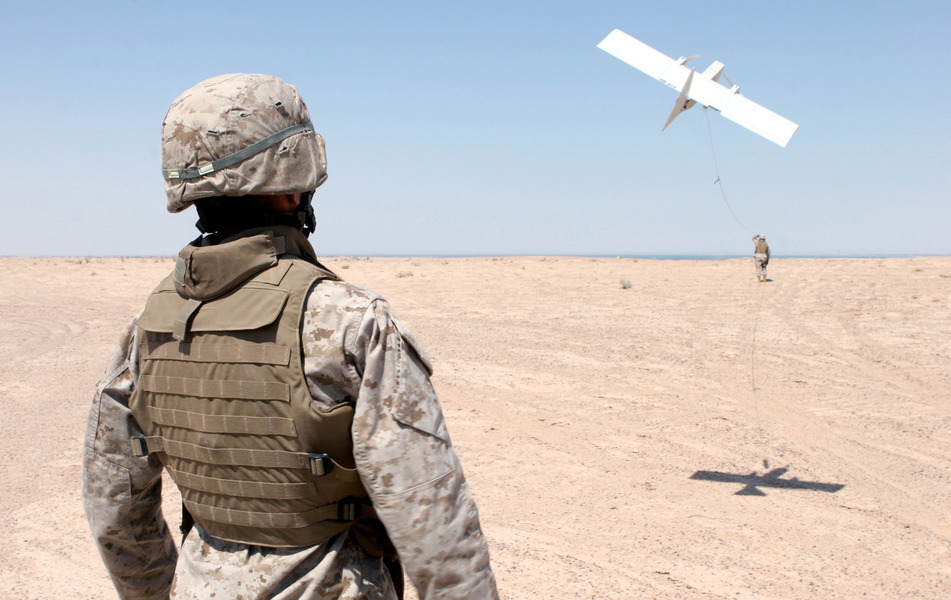The Israel-Iran-Syria Clash and the Law on Use of Force
In the early hours of Saturday morning, an Iranian unmanned aerial vehicle entered Israeli airspace close to the Syrian border. Israel shot down the UAV and responded by attacking the command vehicle, deep inside Syrian territory, that was operating the drone. Syrian anti-aircraft missiles shot down one of the Israeli airplanes that participated in the strike over Israeli territory. In response, Israel bombed a dozen Iranian and Syrian targets in Syria.

Published by The Lawfare Institute
in Cooperation With

In the early hours of Saturday morning, an Iranian unmanned aerial vehicle entered Israeli airspace close to the Syrian border. Israel shot down the UAV and responded by attacking the command vehicle, deep inside Syrian territory, that was operating the drone. Syrian anti-aircraft missiles shot down one of the Israeli airplanes that participated in the strike over Israeli territory. In response, Israel bombed a dozen Iranian and Syrian targets in Syria. According to the Israeli military, it hit eight Syrian targets—including three aerial defense batteries—and four Iranian positions.
The incident continues a string of recent Israeli strikes in Syria aimed at stopping arms transfers to Hezbollah. These strikes have stirred controversy  among commentators. Scholars including Oona Hathaway have criticized Israel both for failing to provide a legal justification for its strikes in Syria and for violating the U.N. Charter.
among commentators. Scholars including Oona Hathaway have criticized Israel both for failing to provide a legal justification for its strikes in Syria and for violating the U.N. Charter.
Saturday’s incident raises important questions about the interpretation of the rules of international law governing the use of force and the legality of the use of force by Israel and the forces acting against it. It is important to note that some of the facts about these events have yet to be disclosed, and we therefore base parts of our analysis on unverified media reports. Nevertheless, what we do know allows for a preliminary analysis of the application of international law in this case.
Syria’s Threat to Israel
The situation in Syria is fast becoming Israel's main strategic problem. Assad's regime, which not long ago seemed to be on the verge of collapse, is gaining strength and receiving considerable assistance from Russia, Iran and Hezbollah. This means that Iran, a state that has threatened to annihilate Israel, is about to gain a foothold near Israel’s northern border. Israel appears to be determined to prevent this. The rising tension and friction among the parties increases the potential for escalation.
Iran, Russia and Hezbollah operate in Syria with the approval of the Syrian government. Generally, the involvement of foreign states in an internal armed conflict at the request of the government of the state where the conflict is taking place is permitted under international law and is not precluded by the prohibition on international intervention by force in another state. This stance, at least in its extreme version, has been criticized by some who have argued that the activities of foreign powers during a civil war often lead to serious violations of human rights, support for oppressive regimes and, in some cases, violation of the right to self-determination. In the case of Syria, one could see another strategic reason to oppose such involvement: Iran is exploiting its intervention in the Syrian civil war to destabilize the region and threaten Israel, while the citizens of Syria and Israel, not Iran, pay the price. This might not bring the legality of such intervention into doubt, but it may be a good reason to re-evaluate existing law on such “friendly interventions”.
As for the legal framework for the relationship between Syria and Israel, some have argued that there is an ongoing armed conflict between the two states, dating back to 1948, 1967 or the beginning of the recent Israeli military activity in Syria. If that is in fact the case, then the legality of Israel’s use of force in Syria would be assessed under the law of armed conflict, not the law governing the resort to force in the U.N. Charter. This claim, however, is dubious. As Hathaway has explained, even if there has been a “state of war” between Syria and Israel since 1967 (or perhaps 1948), this does not mean that use of force of Israel against Syria is permissible at any point in time, regardless of ceasefire or armistice agreements or the de facto end of hostilities. Recent Israeli military activity in Syria appears to have been limited in scope and targeted in its focus, and does not transform the Israeli-Syrian situation into a full-blown armed conflict.
The Iranian UAV Incident
There can be little doubt that shooting down the Iranian military UAV after it entered Israel’s airspace is an action permitted under international law. However, the legality of Israel’s attack on the UAV’s command vehicle—operated by Iranians deep within Syrian territory—raises more complicated legal questions. Did the UAV penetration trigger Israel’s right to self-defense under the U.N. Charter? Could Israel lawfully exercise its right to self-defense by attacking Iranian targets within Syrian territory?
A preliminary issue in the analysis of this strike is whether the command vehicle and the UAV constitute one target or two different ones. The UAV was operated by the command vehicle, and it was not really autonomous in its navigation features. In addition, the command vehicle could have been operating another UAV or about to operate one. We do not currently have all the facts about these issues.
Self-Defense?
According to Article 51 of the U.N. Charter, a state has a right of self-defense against an “armed attack.” In Military and Paramilitary Activities in and against Nicaragua, the International Court of Justice famously held that “in customary law, the prohibition of armed attacks may apply to the sending by a State of armed bands to the territory of another State, if such an operation, because of its scale and effects, would have been classified as an armed attack rather than as a mere frontier incident had it been carried out by regular armed forces” (para. 195) (emphasis added). It is not clear to what extent this “scale and effect” test applies in the Israel-Iran-Syria case, in which regular forces were involved. But one could argue that the penetration of the UAV was no more than a “frontier incident.” Although it might be viewed as an unlawful use of force by Iran—and Syria—in violation of Article 2(4) of the U.N. Charter, it did not trigger the right to self-defense under Article 51, and the subsequent attack against the UAV control vehicle within Syrian territory was thus unlawful under international law.
However, it is worth considering whether our understanding of what constitutes an “armed attack” here should be informed by the technological realities of modern warfare. It is not a stretch to argue that the penetration of a potentially lethal UAV capable of traveling deep into Israeli territory, targeting civilians, and gathering military intelligence should satisfy the article 51 requirement of an “armed attack.” Under this approach, particularly if we see the UAV and its control vehicle as one target, the strike against the operating vehicle would be lawful. It would arguably meet the necessity and proportionality requirements that apply to any use of force in self-defense, unless there was absolute certainty in real time that the UAV penetration was a one-off operation and that the control vehicle no longer posed a threat to Israel (on this, see more below). The strike against the control vehicle was necessary to prevent further UAV penetrations and proportional in that it directly addressed the source of the use of force against Israel.
A further source of potential support for Israel’s response against the UAV control vehicle might be the doctrine of anticipatory self-defense, that is, launching an attack to prevent or counter an imminent attack before it occurs. There is controversy as to whether a state may lawfully resort to anticipatory self-defense, relying on past attacks to argue that a new attack is imminent. International law does not permit reprisals against past attacks.
In the case at hand, consider two possible scenarios. Under one scenario, in targeting the UAV control vehicle, Israel acted on intelligence about additional UAVs that were making or about to make their way into its sovereign territory. If that were in fact the case, and assuming that multiple UAVs penetrating and threatening strikes on Israel’s territory would rise to the level of an armed attack, then the strike arguably satisfied the imminence requirement for anticipatory self-defense. But let's assume that Israel knew that the UAV operation was a “one off” operation that ended (for that round) when the UAV was shot down. Is Israel allowed to act against the command vehicle, exercising anticipatory self-defense to prevent potential future UAV attacks? Or is this a prohibited reprisal? The answer would depend on one’s interpretation of imminence. There has been some movement towards a more capacious interpretation (see, in particular, Daniel Bethlehem’s influential principles, the U.K. attorney general’s 2017 speech on the law of self-defense and Ashley Deeks on the U.S. position), but the issue remains in flux. It is highly doubtful that anticipatory self-defense encompasses a general goal of deterring future violence, even if one accepts the doctrine.
The Legal Significance of Striking Iranian Targets
The second question that arises with regard to the strike on the operation vehicle relates to Israel’s right to use force in self-defense against Iranian targets on Syrian territory. In the present context, this problem seems to be theoretical, because according to media reports it appears that Iran and Syria are working together in full coordination. Generally, a growing number of states have expressed support for the “unwilling or unable” doctrine, that permits use of force on the territory of a state against a third party without its consent. According to this doctrine, states can lawfully act in self-defense against non-state actors operating from the territory of another state, if that state is unwilling or unable to address the threat itself. In particular, the doctrine, which remains controversial, would apply in cases in which a central government has lost control over parts of its territory. This is in contrast to the traditional view under international law, which holds that if Syria had opposed Iran’s use of its territory to violate Israel’s sovereignty, then Israel would have no right to forcefully interfere in Syria in order to enforce its legal rights.
The case of Iran in Syria adds another complication to the application of the unwilling or unable doctrine. So far, the doctrine has only been invoked to justify action against non-state actors. Iran, of course, is a state, and it is unclear whether and how the doctrine would apply when there is a third state acting from a host state’s territory.
Extending the Assaults and the Risk of a Deterioration
The UAV incident escalated into a fire exchange between Israel and the forces operating from Syria. During the attack on the Iranian command vehicle, the Syrian air-defense system was activated, and an Israeli fighter jet that participated in the control vehicle strike was shot down over Israeli territory. Israel responded by striking Syrian and Iranian targets in Syria. It is not clear whether all these targets were linked to the shooting down of the Israeli fighter jet and the UAV penetration. According to reports, Russian forces were apparently close to the area of the attacks in Syria, although there is no indication that they were harmed. We have no precise information about the extent and purpose of the attacks.
Insofar as Israel was directly responding to the downing of the fighter jet and Syrian anti-aircraft fire in striking the additional targets, it seems that it has a stronger legal argument than it does for the initial strike against the control vehicle. It is hard to argue that intensive fire into Israeli territory would not meet the threshold of an armed attack that would merit the use of force in self-defense. The problem is that we do not know whether all the targets that Israel attacked were linked to the anti-aircraft fire and the UAV threat. Therefore, it is difficult to assess whether this use of force was necessary for stopping the fire and proportional to the harm that Israel had suffered.
Further, some evidence suggests that Israel wasn’t just relying on self-defense in this narrow sense as the legal basis for these actions. Brigadier General Tomer Bar, the head of the Israel Air Force Staff, was quoted by Israeli media as saying (in Hebrew): “This attack was the most extensive Syrian defense operation we have carried out since Operation Peace for the Galilee. We will not allow the continuation of the consolidation of Iranian presence in Syria.”
This statement seems to suggest that Israel’s strike against the additional targets was not only meant to address the sources of the anti-aircraft fire but also to advance broader strategic goals, such as deterring Iranian and Syrian forces from crossing "red lines" that Israel seeks to communicate concerning the conveyance of arms and presence of foreign troops in Syria. This statement suggests that Israel is basing its actions on a different doctrine: the preventive self-defense doctrine.
According to this controversial doctrine, a state has a right to act in self-defense to prevent threats that have not yet materialized in order to prevent an adversary from developing capabilities that would allow them to launch a devastating attack. It appears that this is the basis for Israel’s policy with regard to the Hezbollah’s accumulation of strategic weapons. Over the past few years, it was reported several times that Israel had attacked convoys transporting Syrian and Iranian weapons to Hezbollah in order to prevent the strengthening of this organization. A senior Israeli Air Force official recently stated that “just over the past year” the Air Force has conducted “thousands of actions” in Syria (in Hebrew).
Proponents of the doctrine of preventive self-defense have argued that the nature of modern threats and the danger to civilians as a result of the activities of non-state actors and states that do not play by the rules of international law require the expansion of the right to self-defense, at least in relation to rogue states and terrorist organizations that explicitly threaten to use force and that have a proven history of such use. Opponents of the doctrine point out that such expansion of the right to self-defense permits large-scale use of unilateral force and that it significantly dilutes the prohibition on the use of force enshrined in the U.N. Charter. The reliance on preventive measures also tends to justify the use of force by powerful states at the expense of weak states, undermining their sovereignty. According to opponents of preventive self-defense, the way to deal with the strengthening of rogue states and terrorist organizations is through diplomacy, economic pressure, and the U.N. Security Council.
Israel has a long history of launching preventive operations to stop states from acquiring strategic weapons. Those operations have been motivated by a sense that Israel alone could secure its fate against a broad spectrum of threats on its borders and beyond. Its small territory leaves it little room for tolerating what it views as existential risks. It appears that similar concerns are driving Israel's current operations Syria to counter the efforts of Iran, which has explicitly threatened to destroy Israel, and Hezbollah to entrench their foothold on its northern border.
Israel appears to be alone in this effort: The United States does not seem to be willing to jump into this conflict on top of its existing operations in Syria, while Russia is actively propping up the Assad regime while making it clear to Israel that its strikes in Syria are unacceptable. Moreover, the U.N. Security Council, which is tasked with addressing potential future threats under the collective security framework of the U.N. Charter, has largely failed to act on Syria. The likelihood of a Russian veto has brought any possible Security Council action on the Syrian matter to a standstill. In the same vein, U.N. Security Council Resolution 1701, which restricts Hezbollah's activity in Lebanon, is hardly enforced at all. This is not the place to discuss the ramifications of this failure and the need for reform. In light of the Security Council’s inaction, however, Israel is left with little choice but to address the threats from the north on its own.
Conclusion
There are good legal and policy reasons to reject the preventive self-defense framework. However, we must also recognize the predicament in which Israel finds itself vis-a-vis the threats it faces from the north in the absence of legal tools that would allow it to address those threats. It is interesting to note in this regard that the United States has formally supported Israel's action in Syria on the basis of the "inherent right of self defense," perhaps lending its own voice in support of a broad reading of the U.N. Charter in this case.
Finally, it is important to remember that even if Israel can rely on a relatively broad legal interpretation of the right to self-defense as the legal basis for its actions, it is limited by the requirements of necessity and proportionality of the use of force. Israel’s case for preventive self-defense would be more credible if it rigorously abides by these requirements.



.jpg?sfvrsn=82a6ee72_5)


